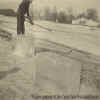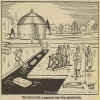| Natural ice was only harvested during the coldest winter months to make sure that the
ice was thick enough to work on and create large blocks of ice. The ice on the Cedar River
was often covered with snow that had to be removed before the ice cutting could begin. The
snow was removed with the help of two large horses that were hitched to a wooden device
called a slip. The slip collected the snow as the horses crossed the frozen river. When
the horses reached the dumping point the trip was released on the slip, which dumped the
snow. This process was repeated until the entire field was cleared. |
 |
Ice Blocks |
|
| The next step in the ice harvesting process was the cutting of the channel. A basic
channel was about two feet wide. It was generally cut to a depth of about six inches
using power-driven saws. These saws came into use during Smith's years at the Cedar Falls
Ice and Fuel Company. The remaining cutting was done by hand using deep-toothed, one-man
saws. The channel ice was then chopped up and slid under the ice to get it out of the way. |
 |
Comic |
|
| Then, using handsaws, the men would cut the ice into sections containing about
40 blocks. When these sections floated free, they were pushed to the channel. After the
blocks reached the channel, the "spud" men took over. A spud was a one-inch
diameter steel bar, with a handle on one end and a wide-tapered chisel on the other end.
"These men were craftsmen knowing just where to drive the spud into the ice to make
four pieces break off and float into and down the channel." In order for the
ice blocks to move down the channel, pike poles were used to push or pull them toward the
elevator and icehouse. |
 |
Ice Saw |
|


![]()
![]()